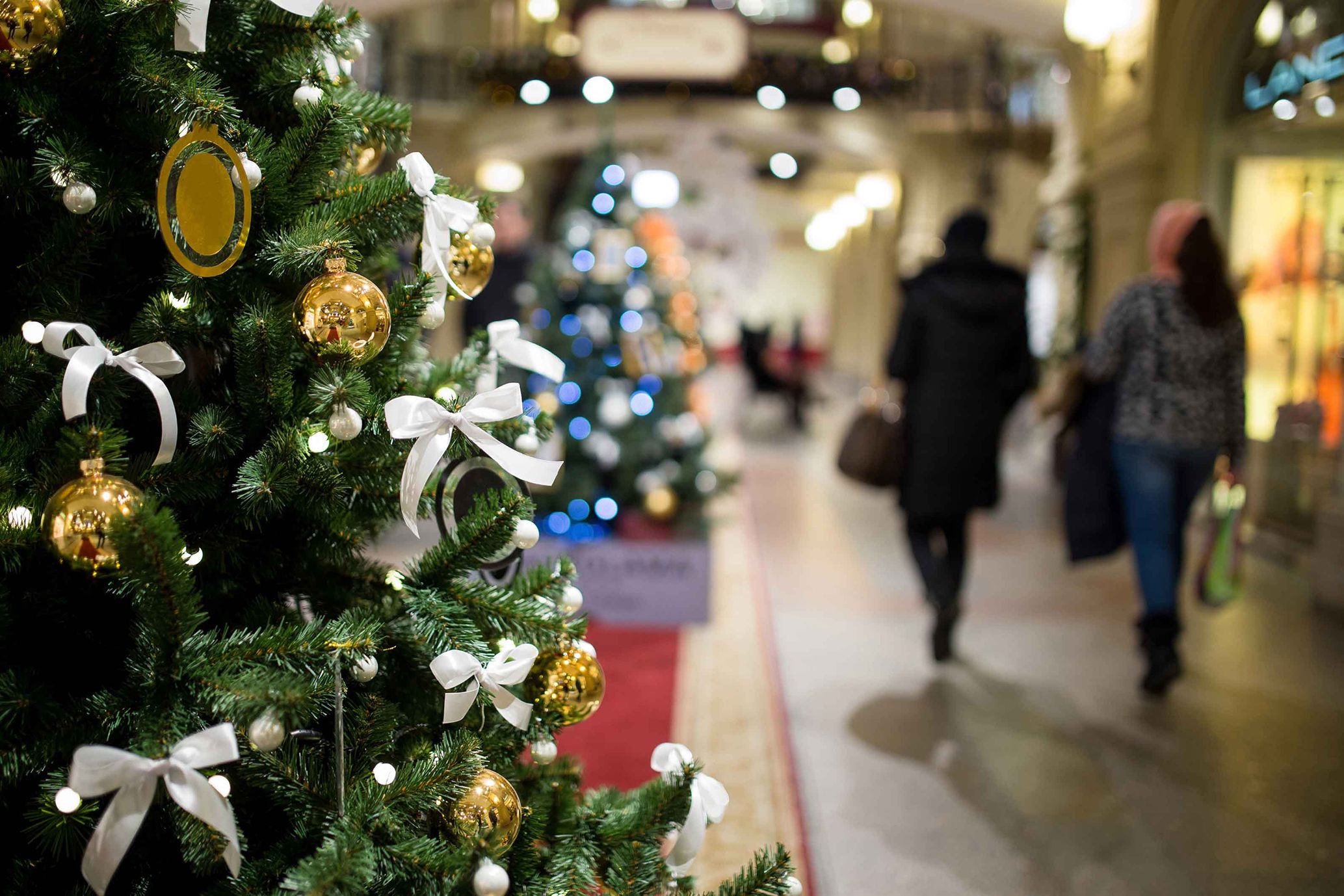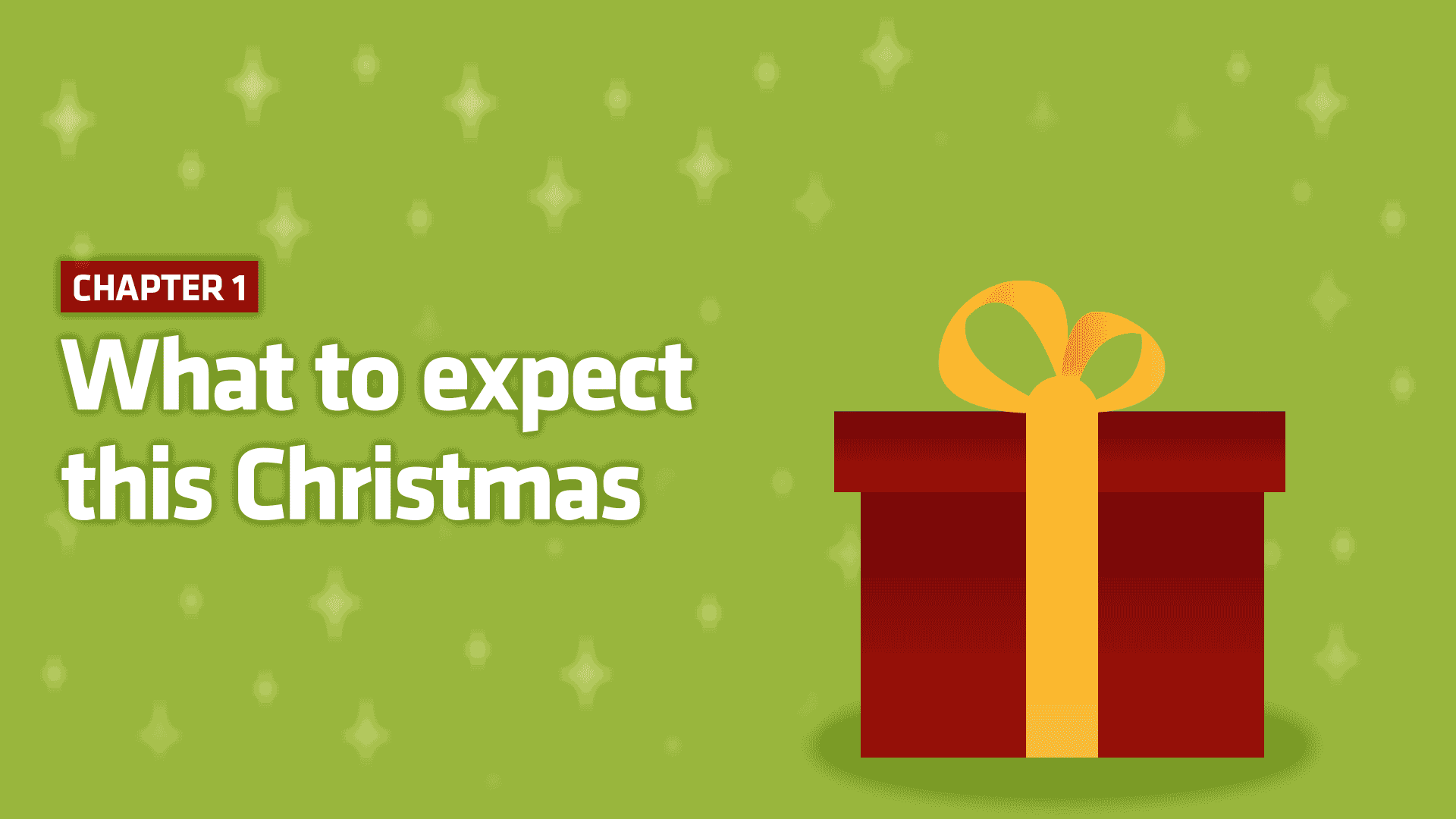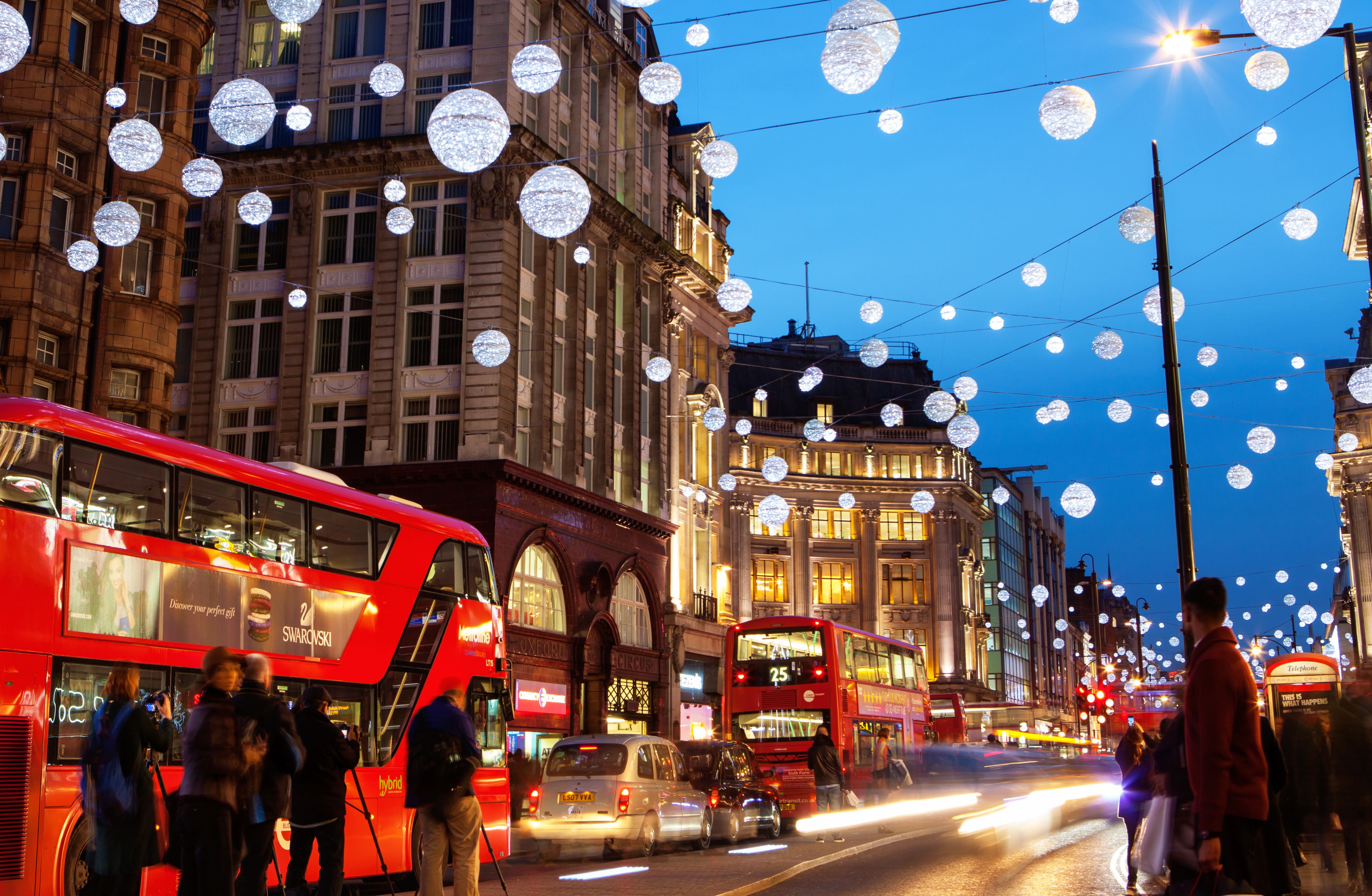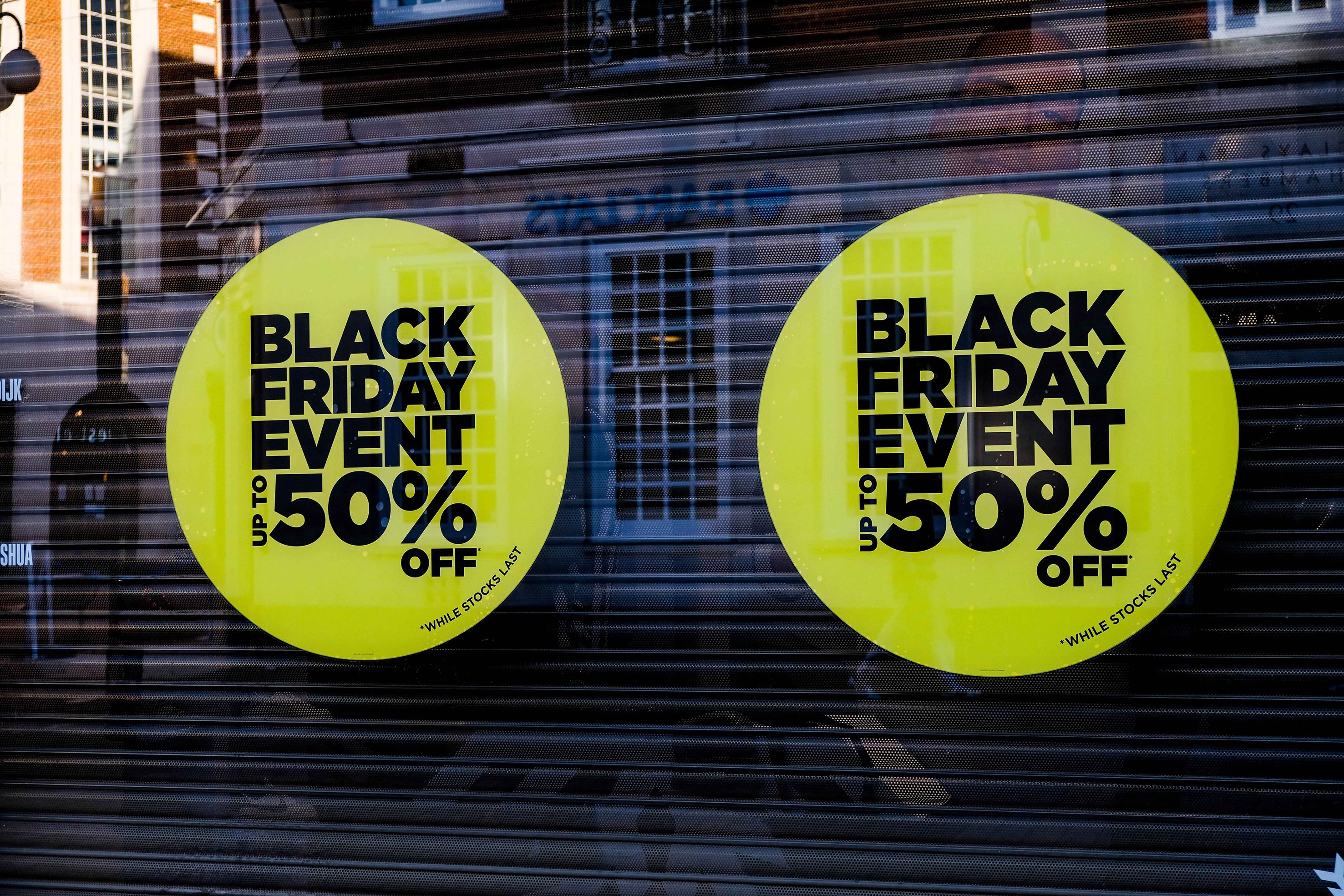

The golden quarter is ripe with opportunity and the most lucrative time of year for retailers – but a bad Christmas can lead to businesses crashing in the new year. Therefore, it stands to reason retailers meticulously plan for the festive season many months ahead.
Capitalising on the annual industry event Christmas in July, traditionally a time when retailers look towards the golden quarter by unveiling what they expect to be the big product trends, our third annual Christmas Forecast report will help retailers prepare for Christmas 2023.
This report will tell you how to strategise to make this Christmas a success, with exclusive category-based sales forecasts and analysis from Retail Week, leading retailers and our report sponsors CommerceHub, Elavon, Experian, Newton and Zendesk. We explain how to get the most out of your data, which technologies to leverage, and how to optimise your supply chain, from fulfilment to returns and sustainability.
The ongoing Russia–Ukraine conflict, cost-of-living crisis and soaring interest rates are still negatively impacting economic rationale. However, they are offset somewhat by resilient employment, a potential fall in inflation rates in Q4 2023 and a sharp boost in consumer confidence reported in recent months, according to independent retail insight provider Retail Economics.
In June, data and research company GfK’s Consumer Confidence Barometer showed that, despite being deep in negative territory at -24, there was an increase of three points – cementing the fact that consumer confidence is slowly returning.
According to GfK client strategy director Joe Staton: “Despite the fierce economic headwinds of the cost-of-living crisis, double-digit grocery price increases and the mortgage squeeze severely impacting both homeowners and renters alike, the UK Consumer Confidence Index has improved by another three points in June, the fifth monthly improvement in a row.“
Retail Economics chief executive Richard Lim says there is a silver lining for the impending golden quarter: “Compared to the end of last year, the macroeconomic environment looks much more positive than we were expecting.
“Heading into last Christmas we had financial market instability; consumer confidence was at an all-time low – lower than the depths of the financial crisis and the pandemic; and the Bank of England predicting a long recession. It was very much all doom and gloom.
“Fast forwarding to where we might be this Christmas, it feels like the macroeconomic environment is going to be better, and where we are now is a lot more positive than where we were six months ago.”
Therefore, while consumer confidence may be markedly up on last year, it’s not time for retailers to breathe a sigh of relief just yet.
The improvement in the macroeconomic environment has been welcome news to retailers, but the sector isn’t out of choppy waters yet. Consumer behaviour continues to change, with competing trends towards both low prices and discounts versus an increasingly environmentally and socially aware cohort of shoppers, and a near kaleidoscopic approach to channel hopping to browse, discover and buy. A recent survey on consumer behaviour showed that 85% of UK shoppers visited two or more sites before making a purchase.
So, how can retailers drive sales over the golden quarter in a climate that, while more tentatively optimistic, is still bearing the battle scars of a challenging few years?
The data behind The Christmas Forecast
This report incorporates exclusive data from independent research consultancy Retail Economics, including forecast data for Q4 2023 and comparison data for Q4 2022.

Consumer confidence may be up, but retail has yet to breathe a sigh of relief
Consumer confidence may be up, but retail has yet to breathe a sigh of relief

Inflation remains stubbornly high
The cost-of-living crisis played a large part in the economic turmoil of the golden quarter in 2022, so what impact will inflationary pressures have on Christmas 2023?
Inflation remains high at 7.9%, with key components such as food being notably painful for households, particularly the least affluent who spend disproportionately in this area.
With real household disposable income (RHDI) falling 2.5% in 2022, the March 2023 Office for Budget Responsibility (OBR) forecast highlights continued concerns in this area. With the RHDI expected to fall by 2.6% in 2023, households will continue to see an erosion of spending power throughout the year.
As ever, there will be significant polarisation between household affluence groups, with 38% of consumers financially distressed, 28% squeezed, 22% being extra cautious, and only 12% financially immune, Retail Economics research shows.
Unsurprisingly, the least affluent are being impacted the most, but Gen X (those born between the mid-1960s to early 1980s), who are typically more indebted and disproportionately being impacted by the rise in interest rates, are also finding the environment more challenging.
Consumer spend will also be heavily impacted by interest rates this golden quarter, with rates now the highest since the global financial crisis and further rises expected this year set to cause more misery.
Retail Economics' Lim predicts: “We estimate that 4 million households are likely to see significant pressure on housing affordability over the course of 2023. Rates remain much higher than this time last year.”
As a result, this will have an impact on Christmas trading for retailers. Our data shows that this golden quarter will see polarised spending. There will be a cohort of customers able to disproportionately spend more money while others will really feel the pinch and trade down to cheaper retailers, benefiting the discount side of the market.
Lim explains: “If you look at households across the UK, the richest 20% are responsible for 40% of all consumer spending. How that translates to retail spend is that if you’re in that part of the market you’re selling luxury products to affluent consumers, and if you’re in the right part of the market then spending is much more protected.
“To summarise, at the top end, the crisis doesn’t concern them; those in the middle are trading down; then there is the bottom end where they are genuinely financially distressed, and are cutting back and focusing on essentials.”
Katie Quarmby, director at operational consultancy Newton Europe, adds: “With middle-income households being more deeply affected by the cost-of-living crisis this year, and more people trading down, buying less or buying dupes – behaviours that have become more like habits recently – retailers may need to re-evaluate who they’re marketing to and their propositions.”
It is the squeezed-middle retailers with no value proposition that are under the most pressure this Christmas.

A cautiously positive outlook for Christmas 2023
However, while there are clearly significant factors that threaten a similar economic outlook to 2022, there are glimmers of hope for Christmas 2023.
While inflation remains high, it is expected to fall rapidly as the end of the year approaches, with the latest forecasts from the Bank of England predicting it to drop to 5.1% in Q4 2023. And the ease on finances is expected to support more solid levels of confidence in the final all-important quarter of the year.
This paves the way for growing consumer confidence, which reached its highest levels in June 2023 since February 2022, with the GfK Consumer Confidence Index score increasing three points to -24.
Although it’s wise to note that while optimism has risen for the outlook for personal finances and the economy, this is not the case for major purchases, which remain challenged.
Recovering consumer confidence
BRC chief executive Helen Dickinson agrees there is positivity ahead. Dickinson said in May that, while households are still feeling the squeeze from the high cost of living, sales growth improved in April. However, consumers continued to adjust their spending patterns, looking for lower-priced alternatives on many key products, leading to falling sales volumes.
She said: “Sales should improve further as we enter the summer months, especially with inflation starting to ease and consumer confidence slowly stabilising. The government must ensure it does not sabotage this momentum by adding cost pressures on to retailers from new policies, as these will mainly serve to push prices back up for people up and down the country.”

Christmas sentiment is evolving
The arc of Christmas trading is changing dramatically. Retail Economics data shows that the build-up to Christmas continues to move forward each year as consumers spread the cost of festive activities and take advantage of Black Friday to purchase products.
Looking at what will drive consumer spending during the golden quarter, Retail Economics notes that low unemployment and strong vacancy rates are driving nominal wages.
ONS reports that the UK employment rate was estimated at 76% from March to May 2023, 0.2 percentage points higher than December 2022 to February 2023. This will help bolster spend in the golden quarter, with unemployment expected to remain near historic lows of 4.3 million by Q4 2023, according to Retail Economics – a slight improvement on previous forecasts.
While the economic toll of the pandemic has been vast, it has allowed household savings to remain higher, yet this is relative to and disproportionately concentrated towards middle- to high-income households.
Looking at consumer behaviour from a psychological point of view, Humanising Brands founder and chief behavioural officer Kate Nightingale says: “Although many consumers might forgo some non-essentials or try to find a better deal on them, many will also look at them as an investment opportunity.”
Analysing how retailers can drive that all-important purchase for Christmas, Nightingale says it is more about what motivation your product or brand activates, and how important and valuable that motivation is to your customers.
“Something that might seem non-essential can actually be necessary to a particular customer or your campaigns can make it seem necessary. For example, products creating intimacy and bringing family closer together or those that create a positive impact on mental health can be really impactful this festive season.”
“Products creating intimacy and bringing family closer together or those that create a positive impact on mental health can be really impactful this festive season”
What is driving consumer browsing, discovery and purchase journeys and how can retailers really connect with consumers' main motivators this Christmas? Authenticity and creating a brand that symbolises trust is key.
Nightingale advises: “People trust recommendations from friends and family more than branded content or even influencers on social media, although these still hold a lot of value to brands as long as they perfectly resemble your customers and are very authentic.”
Newton Europe's Quarmby says: “Understanding customer motivations and which products are going to sell is also vital from an operational perspective. The last thing you want is to generate demand for items that can’t be replenished quickly enough, or at all, or to over-order stock that might be difficult to shift after Christmas, even at a hefty discount. Retailers need to ensure their commercial strategy, operational strategy and marketing strategy are all properly aligned.”

Leverage ‘smart indulgence’ this Christmas
Kate Nightingale, founder and chief behavioural officer, Humanising Brands, believes that this year consumers will attempt to achieve a sense of ‘smart indulgence’
Why indulgence? During times of uncertainty people tend to behave in one of two ways: become more moral and prosocial or more indulgent and impulsive. Which of these reactions dominates is dependent on the psychology of the individual as well as the specific circumstances in the moment. However, due to the season of celebrations, indulgence is socially acceptable and therefore more likely to dominate across the board.
Why smart? The economic challenges consumers are facing with many householders having to be smarter with money will likely lead to slightly more mindful shopping behaviours.
Combined with a growing need to earn extra money on the side through various forms, we will see some interesting consumer behaviour this festive season, from swapping, resale, DIY and even services exchange, to simply searching for the best deals on some less emotionally charged items.


Christmas 2022 may be in retail’s rear-view mirror, but there were important lessons to draw on that will influence retailer strategies this golden quarter.
As predicted in our 2022 Christmas Forecast report, value growth was driven across food and grocery last year, with the festive period seeing shoppers celebrating across categories and price points.
In food, while more than 1.3 million new customers shopped at discounter Lidl to save money, M&S reported its highest-ever Christmas sales of £80m for the three months to December 23, 2022.
Gifting also reported a strong performance, with Argos proving to be the standout brand for Sainsbury’s. The supermarket's sales rose by 7.1% in the six weeks to January 7, 2023, compared with the same period in 2021, with Argos driving strong sales across must-have lines such as air fryers.
Likewise, Poundland reported seven of its busiest-ever days during the period as customers flocked to buy more novelty £1 gifts and chocolates for friends and family. Indeed, Pepco Group, the owner of Poundland, Pepco and Dealz reported total group revenue of €1.6bn (£1.4bn) for the three months to December 31, 2022.
Tesco recorded a 6.1% increase in like-for-like sales for the 19 weeks to January 7, 2023, up 7.8% during the key three-week Christmas trading period. Chief executive Ken Murphy said much of its Christmas success may have come at the expense of pubs and restaurants as customers looked to save money over the period by entertaining at home.
Marks & Spencer chief executive Stuart Machin said customers had looked forward to enjoying Christmas at home: “All our own insight told us customers wanted to celebrate and we saw that in both sides [food, and clothing and home] of the business.”
While Lidl’s Christmas sales rose 24.5% over the four weeks to December 25, 2022, chief executive Ryan McDonnell noted: “We know they switch to us to make savings but they stay with us when they realise that they’re not having to compromise on quality – and this Christmas was no exception.”
Tesco and Sainsbury’s also saw positive results from investing heavily in value own-brand ranges and their respective Aldi Price Match schemes, with Christmas food sales up 7.8% and 7.1% respectively.
M&S locked down the prices of many staple items and its ‘Remarksable Value’ range proved popular – up 27%. Sales of M&S Collection premier-tier products grew 20%, while Tesco Finest was up 8.2% and Sainsbury’s Taste the Difference was up 10%.
Asda saw growth last Christmas with sales up 6.4% over the 12 weeks to December 25, 2022. The grocer’s proposition senior director Alex Newbould said: ”We had a strong Christmas in 2022, performing ahead of the market. However, there was a divergence in the market overall, with both discounters and premium retailers seeing record growth as the economic climate continued to impact on household spending, yet shoppers still wanted to treat themselves with quality products at home.
“Our proposition for customers was strong and we are building on that this year, facing into any current barriers to shop at Asda at Christmas. For this reason, we expect this Christmas to be equally as strong as last year for us, if not stronger.”
Pureplay retailer The Very Group invested in lower prices over Christmas. While that may have affected the top-line growth number, it delivered on the needs of Very’s customers and drove a market share gain, with the group reporting retail sales up 2.2% year on year.
We’ve reflected on last year’s Christmas trading period, but what can retailers expect in 2023?
Most sectors have seen value increase due to high inflation but volumes decrease as consumers feel the financial pressure. The exceptions are fashion and health and beauty, where competition will be high.
Looking at what these figures mean for this year’s golden quarter, our data reveals an interesting sector breakdown.

M&S reported its highest-ever Christmas sales of £80m for the three months to December 23, 2022
M&S reported its highest-ever Christmas sales of £80m for the three months to December 23, 2022

Poundland owner Pepco reported total group revenue of £1.4bn for the three months to December 31, 2022
Poundland owner Pepco reported total group revenue of £1.4bn for the three months to December 31, 2022
Food and grocery
High levels of inflation will drive value growth across the category, with sales expected to rise by 6% in Q4 2023. However, with inflation expected to be in the region of 8.5%, it will imply a decline in volumes of 2.3%.
With incomes remaining under pressure, consumers are expected to continue to trade down to own-brand and private label, while consumers will continue to migrate to the discounters with their market share expected to rise on the previous year.
Grocers will also continue to invest in prices and reposition their brand, but it won’t be enough to offset an overall rise in food prices, despite inflation falling from highs earlier in the year.
This will inevitably leave the discounters in a stronger position than their more expensive peers. Those at the higher end of the market will have to put increased focus on customer communication to make them aware of both the value in terms of the quality of their product and their own value in terms of price and deals.
Homewares
Homewares sales are expected to rise by around 3% in Q4 2023 compared with the previous year. However, growth will be entirely powered by inflation, albeit levels will have moderated in the year's second half.
Volumes are therefore expected to fall by 3.3% against the previous year as consumers cut back on non-essential household spending.
Our research shows a net 14% of consumers are intending to cut back and spend less on household products this year.
Additionally, the impact of the pandemic brought forward a considerable proportion of spending in this area. The pandemic “hangover” impact in this category continues to persist.
Fashion
Apparel is expected to see value growth of 6.2% in Q4 2023. However, this will be helped by high levels of inflation with volumes expected to rise by only 1.6%.
This makes the fashion sector one of only two categories expected to be up at Christmas 2023.
According to Retail Economics' Lim: “Against a backdrop of challenging conditions, apparel is expected to be one of the stronger performers, helped by the continued back-to-office momentum, a cost-effective option for gifting and a sharper moderation in inflation than other categories.”
Parts of the sector will continue to face tough headwinds as consumers cut back on leisure events, having an impact on demand for new outfits. Our research shows that a net 11% of consumers are planning to cut back in this area as budgets remain under pressure and consumers prolong the replacement cycle of products.
However, a polarised market can be expected, with luxury brands continuing to perform strongly driven by demand from affluent households.
Electricals
Value growth of electricals is expected to decline by 3.3% despite inflation of 5.3%, suggesting a volume decline of 8.2%.
Our research shows that a net 16% of consumers expect to cut back the amount they spend on electricals this year, the sharpest decline across all retail categories measured.
Electricals is a very price-sensitive sector, and retailers will find it difficult to pass on escalating costs against a backdrop of squeezed household incomes and softer consumer confidence.
The sector also faces cyclical challenges as the latest generation of games consoles provides less support and tougher annual comparisons.
Last year, the men's football World Cup helped boost sales of electrical products over the Black Friday period, which will also make for tougher annual comparisons.
Toys and games
Toys and games sales are expected to rise by 6.7% in Q4 2023, driven by inflation of 7.1% over the same period.
This implies that volumes for toy sales will decline by 0.4% compared with the previous year. While supply chains and distribution costs have eased considerably compared with last year, consumers will continue to apply some caution given the squeeze on real incomes.
However, price elasticity in demand for toys during Christmas is relatively rigid, suggesting that households will cut back spending in this category only after trying to cut back in other areas.
Volume growth is likely to hold up relatively well compared with other categories.
Furniture and flooring
Given the big-ticket nature of products and consumers applying more caution in this area, the furniture sector will likely continue to face challenges.
The housing market is expected to continue to slow on last year’s levels, as higher interest rates make housing affordability more challenging.
Therefore, sales values are likely to rise by 3.2%, which will imply a fall in volumes of 3.5% compared with last year.
A softer outlook for the category is also expected given that the pandemic brought forward the replacement cycle of large furniture items.
DIY and gardening
We expect the level of DIY and home development projects to wane in Q4 2023 as cost pressures on incomes in 2023 reduce the number of in-home projects.
Overall, sales values are expected to fall by 3.3% over Q4 2023, with an even sharper fall of 8.9% in sales volumes.
Indeed, large players such as B&Q have released lacklustre results in recent trading periods with a subdued housing market softening the backdrop for sales.
At the time of writing, B&Q parent company Kingfisher was the second most shorted stock across major investment houses, suggesting the share price is expected to be under pressure in the coming months.
Health and beauty
Health and beauty is expected to be one of the strongest-performing categories in the final quarter given the non-discretionary nature of many products within the sector.
Retail Economics research shows that a net 4% of consumers expect to spend more in this area in the lead-up to Christmas. Overall sales are expected to rise by 5.9%, with volumes also rising by 0.4%, year on year.
Gifting is expected to be a popular choice among shoppers who are eager to treat family and loved ones instead of giving presents with more functional purposes in the tough economic environment.
As we’ve consistently seen during times of economic hardship, many consumers are likely to treat themselves with affordable little luxuries such as lipstick instead of larger purchases.

While Christmas retail preparation begins in earnest around July, it’s safe to say that retailers are constantly strategising ways in which to capitalise on the period.
Prepare and conquer
Preparing for Christmas 2023 means getting supply chains in order. Fulfilment comes under huge strain during Christmas due to the volume of deliveries and enquiries.
Philip Hall, managing director for Europe at CommerceHub, a commerce network connecting more than 40,000 global retailers such as Walmart and Under Armour, highlights the challenge: “With the arrival of the festive season comes a surge in consumer demand and expectation. People want their orders and they want them quickly. Ensuring your fulfilment capabilities are robust can make the difference between soaring or sinking this Christmas. Whether you’re using drop ship, direct or third party, seamless integrations between your sales channels, order management systems, fulfilment and logisitics are crucial for fast and smooth deliveries.“
Elavon head of professional services for Europe James King shares how important it is for ecommerce businesses to develop an excellent relationship with a delivery firm.
In an online survey of 1,000 adults across the UK carried out by the global payments company, two-thirds of respondents said free returns, labels and packaging would encourage them to shop online. A similar proportion (61%) said reliable delivery is a key reason to encourage online shopping. Respondents also said they are keen in same-day delivery (42%), returns collected from their house (39%) and a wider range of delivery slots (28%).
King adds: “This really underlines how important it is for you, as an ecommerce business, to develop an excellent relationship with a delivery firm.
“We also see younger shoppers keen for same-day delivery, while a sizeable minority of all shoppers also like that availability. Something to consider to help you compete with the high street or have an edge over competitors.
“We know people are tightening their belts because of the economic situation so you’ve got to work even harder to win over customers.”
Lim highlights how a prepared approach can offset these challenges, emphasising that planning is key, especially when it comes to logistics.
He says: “Make sure that you have good relationships with partners and the technology behind that to support trading through peak. It’s essential to get all of those pieces of the jigsaw in place. Ensure you have flexible capacity to deal with peak effectively, trusted partners – and that can be couriers, dispatch, warehouses, third-party logistics model – and have the planning process in place.”
Hall says ecommerce businesses will need to approach these challenges with a holistic view, prioritising profitable product lines and channels, accurate inventory management across all sales channels and a robust fulfilment strategy.
He explains: “At CommerceHub, we’re seeing both brands and retailers focusing business efforts on profitability. Many businesses are now looking at their business models going forward and working out how to grow, but also de-risk at the same time.
”By diversifying sales channels, scaling back on less profitable product lines, looking into new approaches like unowned inventory and reviewing returns strategies, businesses can mitigate some of the economic challenges and drive profitable growth.
“Technology is the foundation for success, helping brands and retailers navigate these challenges and drive efficiencies across their ecommerce operations to make the most of the peak season this year. Whether that’s optimising product listings, reducing the time to get products online, expanding reach with new marketplace or retailer integrations, real-time inventory updates or adopting new fulfilment models, having the right technology partner in place is key.”
Eric Jorgensen, VP EMEA at Zendesk, adds: “Retailers should now be thinking about the value proposition they bring for their customers during this busy time because even though consumer confidence is on the rise, investment in CX remains critical for businesses to succeed during this season.”

Ready for returns
The Christmas period may be ripe with sales opportunities for retailers of all shapes and sizes, but the hangover comes in the form of an increased volume of returns.
This presents retailers with multiple challenges from reprocessing to refunds and difficulty in financial forecasting.
This isn’t a new challenge – it’s one that retailers are used to dealing with, particularly at Christmas and in the period that ensues.
This Christmas, the picture will remain challenging, says Newton Europe's Quarmby. “Despite the forecast decline in total sales volumes this Christmas, our analysis suggests that we will see an increase in the overall volume and value of returns, not a decline – driven by the resilience of the apparel market, which has the highest return rate of any category.”
She adds: “Across the board, the news that interest rates will continue to rise as inflation refuses to fall by as much as expected, coupled with the predicted drop in sales volumes, could also indicate that shoppers will be more discerning in their keep/return decisions this Christmas, and more likely therefore to send items back due to affordability, increasing return rates beyond historic norms.”
This is compounded by research from Newton, which suggests returns cost retailers on average 6% of the RRP of all sales – which it says is due to a lack of ownership, control and visibility of operations and where the biggest issues and opportunities are in the end-to-end returns process.
Newton’s analysis of major retailers suggests the absolute value of returns will increase by 0.5% to 4% this Christmas season and that the number of returns will increase by 1% to 2%, which it says is a conservative estimate.
The furniture and flooring sector, which is forecast to experience a significant decline in sales, could be harder hit. Quarmby says: “This could be the ‘sleeper agent’ that hurts retailers’ P&L accounts as it has the third highest inflation rate, including food; the highest return cost per unit; and customers are more likely to question their higher-value purchases.”
What can retailers do?
Questions remain over how sustainable the current returns model is, both in terms of ease and cost to the consumer.
In fashion, an area where high levels of returns are a constant, retailers such as Zara, Boohoo and New Look all made headlines when they began charging for returns – despite the macroeconomic environment.
However, this may not be the answer for everyone during a cost-of-living crisis. A better solution may be to look at reducing the cost to the business of returns. Zara, for example, allows customers free returns for products returned to stores, a move that reduces the complexity of managing its returns.

A personalised Christmas
Data is, once again, going to play an important role this golden quarter. Lim says it is those retailers that are able to leverage it in an agile way that will have a competitive advantage over those who don’t this Christmas.
Lim adds: “The use of data goes back to personalisation, about reaching out to customers at the right time with the right offer to try and maximise profit.”
According to Experian vice-president of solutions Steve Farr: “Data can also be used in other ways to make a retailer’s shopper experience stand out from the competition. Take, for example, click-and-collect services. Do you offer convenient locations? And that doesn’t just mean how close they are to the customer (crow-flies distance), but how fast they can get there and how convenient it is get to the store given available means of transport.”
Farr also highlights how data about transport networks, travel times and geolocations pinpointed to exact delivery locations – rather than addresses or postcodes – make for a much-enhanced shopper experience that will encourage them to come back for more.
Zendesk's Jorgensen adds: “In 2023, consumers have infinite purchase options, so businesses need to work smarter to provide a greater experience to consumers with every interaction. This is where the power of AI can help with forecasting, personalisation and more efficient service overall.”
Dobbies Garden Centres chief executive Graeme Jenkins says data is playing a crucial role within his business: “As our Club membership base grows, we are in a position to learn from the data we have, while delivering targeted and personalised messages that are relevant to our members.”
Newton Europe's Quarmby adds: “By taking the data they already have, and applying data science and analytics, retailers have the ability to make more informed choices about everything from big-bet products to price points and how to ramp up staffing levels – so that they don’t end up kidding themselves with sales that are undermined by profit-eating inefficiencies.
“Beauty advent calendars are a great example of a product that sells well but over-indexes operationally due to high production costs. Retailers must leverage their data to understand what the net value of these so-called bestsellers really is and feed that into their commercial plans. They then need to work in a more joined-up way across all teams – from buying and merchandising through to operations and stores – to ensure they’re in the best possible position to perform well throughout the season.”

Sustainable spending
Rental, resale and pre-loved has moved from the margins to the mainstream and this will impact purchasing decisions this Christmas.
Half of Britons plan to buy pre-owned items this year, according to an eBay survey conducted in December 2022. TV series Love Island partnered with eBay to bring sustainable fashion to TV screens in 2022, with eBay global general manager of the home, garden and refurbished categories Murray Lambell stating: “I believe that Love Island's decision to have contestants dressed in pre-loved fashion has had a big role in this [consumer trend].
“For me, this trend shows two things. The first is that shoppers in the UK continue to display the behaviour of the most sophisticated consumers in the world. Only a few years ago, there was a stigma attached to buying pre-loved, particularly in categories like fashion and furniture, which held the trend back.”
Consumers are both responding to sustainable developments and creating new markets for retailers to move into
Now the evidence is that consumers are both responding to sustainable developments, such as Love Islanders wearing pre-owned items, and creating new markets for retailers to move into.
Lambell has said: “To underline that point, our data shows a 1,600% increase in searches for pre-loved clothing last year vs 2021 and a 24% jump last year in the number of businesses selling pre-loved items on our platform.“
According to Lambell, it is not just fashion. “We’re increasingly seeing demand for other pre-loved items, such as furniture, and tech like smartphones and laptops.”
The rise of retailers entering third-party partnerships with rental platforms – such as Asos and Hirestreet in May 2023 – is also emphasis of a wider shift.
How should retailers look to capitalise on this trend?
Nightingale says that, due to the impact of uncertainty on human psyche because of factors such as the cost-of-living crisis, combined with growing interest in social impact and creating positive difference, as well as the peer pressure of the festive period being a giving season, we will see an uptake in interest in social enterprises, ethical and sustainable brands.
“I think this can be especially visible in gift shopping as people will want to show themselves as caring about these causes,” she says.
This was highlighted by Dobbies’ Jenkins. When discussing lessons learnt in Christmas 2022, he highlights that adopting an eco-focus gave the retailer an edge over competitors: “Our fantastic selection of sustainably sourced real Christmas trees and houseplants gave us a point of difference to other retailers, and we intend to build on this success in 2023.”
ROI this Christmas: getting the biggest bang for your buck
From legacy back-end systems creaking under the strain of multichannel retailing to outdated stores, consumer hunger for new products and desire for ever faster and more convenient deliveries, retailers are constantly faced with a very long shopping list of potential investments.
But where should retailers place their tech bets this golden quarter?
Lim says digital transformation continues to be critical and particularly notes the potential benefits of automated intelligence: “This can be anything from automating and digitalised supply chain using data and AI for automated ordering processes, right through to having a best-in-class website that can have a single inventory view across warehouses and stores, and to effectively be able to deliver against their customer expectations.”
Allocating spend on AI can also pay dividends. Retailers can leverage technology to better understand their customers, more effectively target advertising, improve the shopper experience, and operate more productively and efficiently with fulfilment and logistics providers. More sales and fewer returns make for an easy ROI calculation.

Retailer insights
We've looked at the forecasts, but how are retailers preparing? Retail Week spoke to leading retailers to find out how they are planning for the 2023 golden quarter and which investments they are making to ensure they capitalise on the opportunity.
Giftware: Gift Universe
Gift Universe chief executive Paul Kraftman tells Retail Week that after outperforming in the 2022 Christmas period, the company is expecting to see more stagnant results this year.
“Christmas performance in 2022, particularly in December, exceeded expectations. As an omnichannel retailer with a significant number of retail stores, we believe we benefited from the well-reported issues within the last-mile supply chain, which meant that consumers returned to physical stores in greater numbers.
“As a result, we are not predicting significant like-for-like growth for Christmas 2023 for the physical stores, although we are planning to open additional shops this year as we see a continued trend for consumers wishing to return to the high street and shopping centres. With respect to digital, we anticipate growth as a result of increased market share through our own strategies around platform, UX and payment initiatives, as well as greater penetration through partner retailer marketplaces rather than market growth.”
And the lessons learned? “Operationally we were not fully prepared for the last-minute spending patterns last year, which were more reflective of pre-pandemic behaviour; this year, we have improvements to our supply chain and planning to address this. In addition, we are strengthening our customer service experience for our digital channels, which came under stress last Christmas, by investing in improved systems, processes and communications.”
Grocery: Sainsbury’s
The grocer’s volume performance last Christmas was ahead of the market for the third consecutive year, driven by investment in value, innovation, service and availability.
Sainsbury’s chief executive Simon Roberts said in the company’s quarterly trading report in January 2023 that the priority had been on creating value for Sainsbury’s consumers in 2022.
He explained: “We prioritised keeping our prices low and giving our customers great value at Christmas. We went bold on the traditional fresh turkey roast dinner with all the trimmings and dessert, which was the best value in the market at under £4 per head. Sales were also boosted by the World Cup as people celebrated more at home.
“Our determined focus on delivering the best value alongside new and exciting festive food plus outstanding customer service and availability meant we delivered record sales, and market outperformance at both Sainsbury’s and Argos.“
Looking forward, Roberts has said he understands “money will be exceptionally tight this year, particularly as many people wait for Christmas bills to land. We are working together with our suppliers to battle cost inflation and we’re keeping prices low again this year with our biggest value campaign yet in January, price matching Aldi on around 300 of our most popular products.”
Garden centres: Dobbies
Dobbies Garden Centres is focused on the buzzword of Christmas 2023: value.
Jenkins says: “Delivering value for our customers will continue to be central in order to achieve cut-through in a highly competitive market. Our value proposition is not just about great prices, it is also the added value we can offer. Our magical in-store experience, including events, shopping environment, Dobbies Club, and inspiration and advice, is our key differentiating factor, backed by digital enablers like our new app and online shopping.
“As our Club membership base grows, we are in a position to learn from the data we have, while delivering targeted and personalised messages that are relevant to our members.“

While market conditions are set to remain challenging, what is apparent is that Christmas 2023 has a brighter future than that of last year. Retailers are already strategising to take advantage of growing consumer confidence.
Drawing on our research, the following are necessities to win this Christmas:
- Having empathetic and authentic communication to match the mood of the nation
- Ensuring commercial, operational and marketing strategies are properly aligned
- Adopting value brand positioning where possible
- Investing in data-driven personalisation
- Embracing technological investments with a focus on AI
Retail Economics' Lim adds: “Tone is really important and is connected to personalisation. The tone that we’re seeing is quite different from the past 12 to 18 months. Retailers are propositioning everything around value for money and having empathetic communication that connects to their customers.”
Likewise, timing matters. Asda’s Newbould says: “We know our customers will be making early efforts to get organised, find interesting products and save money, fuelled by the cost-of-living squeeze.”
Gift Universe highlighted how it was unprepared for last year’s festive season, mistakenly predicting consumer spending patterns to stay the same as during the pandemic.
The same goes for Sales days. We know the potential of Black Friday, but Cyber Week – taking place from November 24 to November 27 – is increasingly important and retailers should place emphasis on an efficient delivery experience to prepare for this.
While the opportunities of 2022, with major events such as the World Cup, no longer exist, retailers now have growing consumer confidence and low unemployment rates to bolster Christmas sales.
If retailers can adapt their strategies to consumer behaviours and follow the insights above, they will reap the rewards.

PARTNER VIEWPOINTS


Philip Hall, managing director for Europe, CommerceHub
The weeks before Christmas are full of opportunity for brands and retailers as they look to capitalise on increased consumer spending and lucrative promotions.
However, the surge in demand and increased competition puts pressure on brands and retailers to efficiently manage inventory and logistics, plan pricing and promotion strategies to optimise product visibility, and deliver exceptional customer experiences. With profitability top of mind this year, ecommerce businesses will need to approach these challenges with a holistic view, prioritising profitable product lines and channels, accurate inventory management across all sales channels, and a robust fulfilment strategy.
With the help of powerful technology, brands and retailers can navigate these challenges and drive efficiencies across their ecommerce operations to make the most of the peak season opportunity. Whether that’s optimising product listings, reducing the time to get products online, expanding reach with new marketplace or retailer integrations, real-time inventory updates or adopting new fulfilment models, having the right technology partner in place will play a vital role in peak season success.
CommerceHub and ChannelAdvisor, a CommerceHub company, offer a suite of solutions that can help brands and retailers get ahead and set themselves up for success this Christmas.


Michael Bosshammer, Head of Retail, Elavon Europe
As growing inflation and economic uncertainty push consumers to tighten their purse strings, there’s one quality that this year’s golden quarter is demanding of retailers and that’s flexibility.
Whether it’s improving the online shopping experience with a seamless returns policy, or encouraging spending in store with more ways to pay, it’s on retailers to remove as many barriers to purchase as possible if they’re to win customers over this festive period.
Capitalise on in-store promotions: Some 60% of consumers are likely to shop in-store when they need something urgently. While it’s not the biggest driver, a customer's need for speed can give in-store shopping a crucial edge over online retail. Retailers should make sure it’s easy for customers to find what they are looking for and can capitalise on this demand further with ‘in-store only’ discounts.
Encourage social shopping: More shoppers are embracing shopping in-store as a social experience, to connect with others as they browse and buy. Retailers can encourage social shopping by ensuring their store is a pleasant place to be, with wide aisles, inviting music and spaces to sit down and relax.
Simplify delivery and returns: Free returns, labels and packaging are a huge incentive for people to shop online. Reliable delivery and extended returns policies can help reduce cart abandonment rates in the Christmas rush.
Offer flexible payments: While consumers are spending more consciously, offering flexible payment methods is key. From in-app payments to buy now, pay later options, consider how you can expand your payment choices to make the consumer’s path to purchase as seamless as possible.


Steve Farr, VP solutions, Experian
To take advantage of growing consumer confidence for a successful Christmas period, retailers will be focusing on opportunities to stand out in their market. Digital will be central to this, and central to digital strategies will be the quality of customer data. Every consumer interaction in today’s digital world is a data point – but this comes with the warning that data is degrading faster than ever.
Good quality customer and prospect records are the baseline for successful customer communication but can also offer unique insights into your customers if enriched with location and demographic intelligence. Retailers can deepen their customer understanding, power decision making and segment more effectively through enrichment.
Savvy retailers are aware that data is their most valuable resource for enhancing the customer experience in order to build loyalty and stand out over Christmas. Experian helps retailers globally to improve their data quality. With broad experience and capabilities, our solutions can help you make the most of Christmas 2023.
- Frictionless capture of contact data: reduce address entry time by up to 80% with autocomplete technology that predicts as customers type.
- Easy to integrate across web forms, CRMs and ecommerce solutions: optimise checkout process to reduce customer effort and increase conversion.
- Correct and validate data in real-time or batch: ensure only accurate data enters your system to improve delivery rates and communicate more effectively through the customer journey.
- Enrich data to drive additional value: MOSAIC demographic profiling, disposable number checks, business vs residential email flags, and more.


Christian Hansen, Partner, Newton Europe
As well as arming themselves with forecasts about what people are going to be spending their money on this Christmas, retailers need to think carefully about their target market and what propositions are going to be the most successful, from the must-have products to pricing and promotions.
It is then essential that retailers align their commercial and operational strategies. Without this, commercial successes will be undermined by inefficiencies in end-to-end operations, from suppliers through logistics to store and online fulfilment operations.
For example, every year we see returns blighting financial results – as volumes go up and add more pressure to already inefficient and expensive systems. With our analysis suggesting that the absolute value and number of returns will increase by 0.5% to 4% and by 1% to 2% respectively this Christmas, retailers would be well-advised to take a more joined-up approach to analysing end-to-end returns and leveraging their data to identify the biggest opportunities for improvement.
The greatest gift a retailer can give itself this year is a properly aligned end-to-end strategy that’s underpinned by granular data and an understanding of what customers truly value, with operations fit to deliver on the commercial promise.


Eric Jorgensen, VP EMEA, Zendesk
Christmas is undoubtedly one of the most stressful periods for retailers but if planned well, it can be the most rewarding time for their business, too.
As consumer spending rises in this busy period, it’s important that businesses can still provide the best economic, as well as sentimental, value for their customers. This is where artificial intelligence can play an integral role by increasing efficiency across all areas of a business while delivering on customers’ expectations.
Tools like Zendesk AI have been designed to provide support to businesses at scale without added complexity. As business costs and wages rise, this efficiency is vital. In fact, 69% of global retail leaders believe AI/bots will drive large cost savings for their businesses in the long term. Intelligent chatbots, in particular, have the ability to anticipate needs, promote self-service and provide instant answers to common customer questions. The Range, for example, found that since incorporating AI into their CX practices, its average first reply time has decreased by 44% year-on-year. This allows CX teams to focus on more complex issues.
Our research found 79% of consumers see AI as an important part of modern customer service. They prefer to use channels that offer quick responses. By analysing previous purchase behaviours, AI can provide personalised offers to consumers, recommending products that they think customers will be interested in buying. As 60% of consumers find personalised recommendations valuable and 62% say they are better than generic recommendations; the employment of AI clearly adds value for customers. Through providing powered consumer insights including sentiment, agents working with AI can deliver value with customer-specific recommendations, from anywhere, faster.
The Retail Week team behind the report

James Knowles
Head of content innovation

Louise Prance
Writer

Caroline Londoño
Business development director

Matt Macdonald
Account director

Hannah Buckley
Account director

Simon Mooney
Senior marketing manager

Alban Bizet
Senior designer

Stephen Eddie
Managing editor

Emily Kearns
Production

Sam Millard
Designer

Leslie Kimona
Digital marketing operations executive

Jed Adkins
Marketing executive






